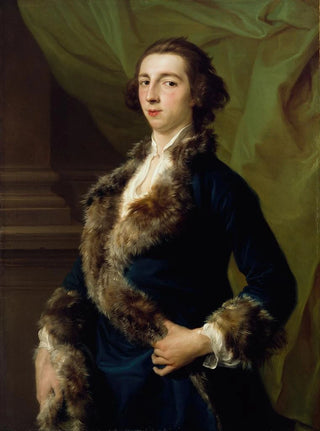Art print | Joseph Leeson, later 2nd Earl of Milltown 1730-1801 - Pompeo Batoni


View from behind

Frame (optional)
Joseph Leeson, later 2nd Earl of Milltown 1730-1801 - Pompeo Batoni – Captivating introduction
In the artistic landscape of the 18th century, Pompeo Batoni's work stands out for its elegance and ability to capture the very essence of his subjects. The art print of Joseph Leeson, later 2nd Earl of Milltown 1730-1801 - Pompeo Batoni, embodies this tradition of portraiture where the personality of the model is highlighted with remarkable finesse. Joseph Leeson, a prominent figure of his time, is depicted in a posture that evokes both nobility and reflection, embodying the values of an enlightened aristocracy. This portrait is not limited to a simple visual rendering; it invites the viewer to delve into the subject's intimacy, to feel the weight of his history and status.
Style and uniqueness of the work
Batoni's style is characterized by an unparalleled mastery of light and shadow, which gives his portraits a rare emotional depth. In this piece, the chosen color palette is both rich and delicate, playing with nuances that emphasize the texture of the clothing and the softness of Joseph Leeson's features. The artist employs a balanced composition, where each element is carefully arranged to guide the gaze toward the count's face, the true focal point of the canvas. The drapery, with its impressive fluidity, seems almost alive, adding a dynamic dimension to the whole. This attention to detail, combined with a keen sense of visual storytelling, makes this portrait a masterpiece that transcends mere style exercise.
The artist and his influence
Pompeo Batoni, born in Lucca in 1708, is one of the most sought-after portraitists of his time, having successfully captivated European aristocracy with his exceptional talent. His artistic journey is marked by travels across Italy and beyond, where he absorbed various schools of painting that influenced him. Batoni does not merely reproduce the appearance of his models; he seeks to reveal their inner character, to express their aspirations and emotions. His influence endures beyond his death, inspiring many artists to explore

Matte finish

View from behind

Frame (optional)
Joseph Leeson, later 2nd Earl of Milltown 1730-1801 - Pompeo Batoni – Captivating introduction
In the artistic landscape of the 18th century, Pompeo Batoni's work stands out for its elegance and ability to capture the very essence of his subjects. The art print of Joseph Leeson, later 2nd Earl of Milltown 1730-1801 - Pompeo Batoni, embodies this tradition of portraiture where the personality of the model is highlighted with remarkable finesse. Joseph Leeson, a prominent figure of his time, is depicted in a posture that evokes both nobility and reflection, embodying the values of an enlightened aristocracy. This portrait is not limited to a simple visual rendering; it invites the viewer to delve into the subject's intimacy, to feel the weight of his history and status.
Style and uniqueness of the work
Batoni's style is characterized by an unparalleled mastery of light and shadow, which gives his portraits a rare emotional depth. In this piece, the chosen color palette is both rich and delicate, playing with nuances that emphasize the texture of the clothing and the softness of Joseph Leeson's features. The artist employs a balanced composition, where each element is carefully arranged to guide the gaze toward the count's face, the true focal point of the canvas. The drapery, with its impressive fluidity, seems almost alive, adding a dynamic dimension to the whole. This attention to detail, combined with a keen sense of visual storytelling, makes this portrait a masterpiece that transcends mere style exercise.
The artist and his influence
Pompeo Batoni, born in Lucca in 1708, is one of the most sought-after portraitists of his time, having successfully captivated European aristocracy with his exceptional talent. His artistic journey is marked by travels across Italy and beyond, where he absorbed various schools of painting that influenced him. Batoni does not merely reproduce the appearance of his models; he seeks to reveal their inner character, to express their aspirations and emotions. His influence endures beyond his death, inspiring many artists to explore






